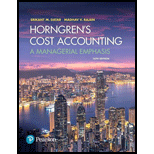
Special order, activity-based costing. (CMA, adapted) The Reward One Company manufactures windows. Its manufacturing plant has the capacity to produce 12,000 windows each month. Current production and sales are 10,000 windows per month. The company normally charges $250 per window. Cost information for the current activity level is as follows:
| Variable costs that vary with number of units produced | |
| Direct materials | $ 600,000 |
| Direct manufacturing labor | 700,000 |
| Variable costs (for setups, materials handling, quality control, and so on) that vary with number of batches, 100 batches × $1,500 per batch | 150,000 |
| Fixed |
250,000 |
| Fixed marketing costs | 400,000 |
| Total costs | $2,100,000 |
Reward One has just received a special one-time-only order for 2,000 windows at $225 per window. Accepting the special order would not affect the company’s regular business or its fixed costs. Reward One makes windows for its existing customers in batch sizes of 100 windows
(100 batches × 100 windows per batch = 10,000 windows). The special order requires Reward One to make the windows in 25 batches of 80 windows.
- 1. Should Reward One accept this special order? Show your calculations.
Required
- 2. Suppose plant capacity were only 11,000 windows instead of 12,000 windows each month. The special order must either be taken in full or be rejected completely. Should Reward One accept the special order? Show your calculations.
- 3. As in requirement 1, assume that monthly capacity is 12,000 windows. Reward One is concerned that if it accepts the special order, its existing customers will immediately demand a price discount of $20 in the month in which the special order is being filled. They would argue that Reward One’s capacity costs are now being spread over more units and that existing customers should get the benefit of these lower costs. Should Reward One accept the special order under these conditions? Show your calculations.
Learn your wayIncludes step-by-step video

Chapter 11 Solutions
Horngren's Cost Accounting: A Managerial Emphasis (16th Edition)
Additional Business Textbook Solutions
Corporate Finance (4th Edition) (Pearson Series in Finance) - Standalone book
Financial Accounting, Student Value Edition (5th Edition)
Engineering Economy (17th Edition)
Horngren's Cost Accounting: A Managerial Emphasis (16th Edition)
Horngren's Accounting (12th Edition)
FUNDAMENTALS OF CORPORATE FINANCE
 Managerial AccountingAccountingISBN:9781337912020Author:Carl Warren, Ph.d. Cma William B. TaylerPublisher:South-Western College Pub
Managerial AccountingAccountingISBN:9781337912020Author:Carl Warren, Ph.d. Cma William B. TaylerPublisher:South-Western College Pub Financial And Managerial AccountingAccountingISBN:9781337902663Author:WARREN, Carl S.Publisher:Cengage Learning,Principles of Accounting Volume 2AccountingISBN:9781947172609Author:OpenStaxPublisher:OpenStax College
Financial And Managerial AccountingAccountingISBN:9781337902663Author:WARREN, Carl S.Publisher:Cengage Learning,Principles of Accounting Volume 2AccountingISBN:9781947172609Author:OpenStaxPublisher:OpenStax College Cornerstones of Cost Management (Cornerstones Ser...AccountingISBN:9781305970663Author:Don R. Hansen, Maryanne M. MowenPublisher:Cengage Learning
Cornerstones of Cost Management (Cornerstones Ser...AccountingISBN:9781305970663Author:Don R. Hansen, Maryanne M. MowenPublisher:Cengage Learning Managerial Accounting: The Cornerstone of Busines...AccountingISBN:9781337115773Author:Maryanne M. Mowen, Don R. Hansen, Dan L. HeitgerPublisher:Cengage Learning
Managerial Accounting: The Cornerstone of Busines...AccountingISBN:9781337115773Author:Maryanne M. Mowen, Don R. Hansen, Dan L. HeitgerPublisher:Cengage Learning Essentials of Business Analytics (MindTap Course ...StatisticsISBN:9781305627734Author:Jeffrey D. Camm, James J. Cochran, Michael J. Fry, Jeffrey W. Ohlmann, David R. AndersonPublisher:Cengage Learning
Essentials of Business Analytics (MindTap Course ...StatisticsISBN:9781305627734Author:Jeffrey D. Camm, James J. Cochran, Michael J. Fry, Jeffrey W. Ohlmann, David R. AndersonPublisher:Cengage Learning





